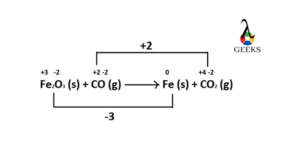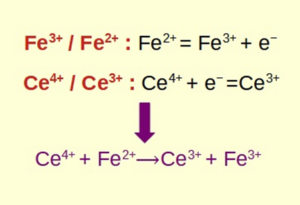In this article, “is oxidation a redox reaction” basic similarities, differences and comparison between oxidation and redox reaction with detailed explanations are discussed briefly.
In redox reaction, oxidation and reduction must be taken place simultaneously. Exchange of electrons is the basic requirement of any redox reaction. But in oxidation reaction, one reactant is oxidized in presence of oxygen or any oxidizing agent to obtain the oxidized product.
Let discuss some frequently asked questions with answers on these two reactions below.
How is oxidation a redox reaction?
Redox reaction is comprised of two different half reactions that occurs together in a single redox reaction-
- Oxidation half reaction
- Reduction half reaction.
Exchanging of electrons between two reactants is the most important criteria to be fulfilled in a redox reaction. These two reactants are basically oxidized and reduced with the help of another reactant simultaneously. In the reduction half equation, reactants must gain electron(s) and in oxidation half reaction, reactant must lose electron(s) to obtain respective product. Number of electrons gained or lost during the redox reaction should be balanced properly to get the correct balanced redox equation.
For example,
Fe2+ +MnO4– → Fe3+ + Mn2+ (Unbalanced redox equation)
- Oxidation half reaction: Fe2+→ Fe3+ + e– ——–1 no equation
- Reduction half reaction: MnO4– + 8H+ →Mn2+ + 4H2O + 5e–——2 no equation
- (1no equation ×5)——— 5Fe2+ → 5Fe3+ + 5e–
- (2no equation ×1)———MnO4– + 8H+→ Mn2+ + 4H2O + 5e–
- Net balanced equation is—— 5Fe2+ + MnO4– + 8H+ → 5Fe3+ + Mn2+ + 4H2O
Oxidation reaction basically signifies lose of electron by any reactant in presence of oxidizing agent. Oxidation number of that reactant is also increased by reacting with oxygen. Loss of hydrogen from any substance is also an example of oxidation reaction.
For example,
- 2Mg + O2→ 2MgO (reacting with oxygen)
- CH3CH2CHO → CH3CHO (loss of hydrogen)
To know more please follow: SN2 Examples: Detailed Insights And Facts
Are all oxidation reactions redox?
Redox reaction known as oxidation-reduction reaction. A redox reaction can be separated into two half reaction i.e oxidation and reduction half reaction. So, oxidation reaction must be involved in redox reaction.
In oxidation reaction, reactants react with oxygen and oxidation number of that particular species is increased in product than the reactant. With that the oxidation number of oxygen or any other oxidizing reagent by which the substance is oxidized is decreased in product. Thus, only oxidation can not take place separately in any reaction.
In redox reaction generally two reactants are present. Electrons are exchanged or transferred from one reactant to another and one oxidized with one reduced species are obtained as product.

In this above example, oxidation number of Fe in Fe2O3 is +3 which is changed to 0 in product side. Thus, this the reduction half reaction and oxidation number of carbon is +2 in CO but it is changed to +4 in CO2. So, it is the part of oxidation half reaction.
Let balance the above equation-
Change of oxidation number for oxidation half reaction and reduction half reaction is 2 and 3 respectively. Thus, net balanced equation is-
Fe2O3 +3CO → 2Fe + 3CO2
What happens in a redox reaction?
Redox reaction is nothing but the electron transfer between two substances. One reactant is oxidized and another reactant is reduced due to exchanging of electrons. In oxidation process, reactant loses its electrons while in reduction, reactant gains electrons in a single redox reaction.

Image Credit: Wikimedia Commons
Let’s account an example to make it clear-
Zn (s) + 2H+ (aq) + 2Cl– (aq) → H2 (g) + Zn2+ (aq) +2Cl– (aq)
In this above example, Zn is oxidized to Zn2+ and lost two electrons and the oxidizing agent is H+. So, the oxidation half reaction is: Zn (s) → Zn2+ (aq). Similarly, H+ is reduced to H2 by accepting two electrons with the help of Zn. Thus,Zn acts as reducing agent and H+ acts an oxidizing agent. Reduction half equation will be 2H+ (aq) → H2 (g)
To know more please check: 7 Tetrahedral Molecule Examples : Explanation And Detailed Facts
What happens in an oxidation reaction?
Oxidation reaction is nothing but the increasing of oxidation number or loosing of one or more than one electron. Oxidation state is increased in the time of oxidation.
It is not always fixed that oxidation can only take place in presence of oxygen, any other oxidizing agent can participate in oxidation reaction. The purpose of adding of oxygen or oxidizing agent is to accept the electrons which are donated by the reactant to obtain the oxidized product. Reverse reaction of oxidation is reduction which is nothing but the gaining of electrons.
Let’s take an example of oxidation reaction-
Iron reacts with oxygen to form the oxidized product iron oxide (Fe2O3).
4Fe + 3O2 → 2Fe2O3
To know more please go through: 5+ Metallic Bond Examples: Explanation and detailed Facts
Redox Reaction vs Oxidation
| Redox Reaction | Oxidation Reaction |
| Redox reaction is basically exchanging of electrons between two participating atoms, molecules or ions. | Oxidation is nothing but donating or loosing of electrons to oxygen or any other oxidizing agent. |
| Redox reaction proceeds through two opposite half reaction, oxidation half reaction and reduction half reaction. | In an oxidation reduction one reactant is oxidized with the help of oxygen and form an oxidized product. |
| Example of a redox reaction is: 2HNO3 + 3H3AsO3 (aq) → 2NO (g) + 3H3AsO4 (aq) +H2O (l). | Example of an oxidation reaction is: 2Mg + O2→ 2MgO. |
Relationship between Redox Reactions and Oxidation Reaction
In a redox reaction, reduction and oxidation take place at the same time. Oxidizing agent (oxidizes other chemical species) accepts electrons from reducing agent (reduces other one) to be reduced. Basically, it is an electron transfer reaction. Oxidized species lose electrons and reduced species gains electron in redox reaction, Thus, redox reaction can be divided into two parts- oxidation and reduction half reaction.
The process, oxidation must be present in a redox reaction.

Image Credit: Wikimedia Commons
In this above example, Ce4+ is reduced to Ce3+ and Fe2+ is oxidized to Fe2+ is oxidized to Fe3+. The above reaction is an example of redox reaction as both oxidation and reduction are involved in this reaction through transferring of electrons between two reactants.
To know more please check: Is HBr Ionic or Covalent : Why? How, Characteristics and Detailed Facts
Also Read:
- Redox reactions
- Nuclear fission reaction
- Nuclear fusion reaction
- Decomposition reaction example
- Perkin reaction
- Exchange reaction example
- Metathesis reaction
- Light independent reaction example
- Knoevenagel reaction
- Photochemical reaction

Hello,
I am Aditi Ray, a chemistry SME on this platform. I have completed graduation in Chemistry from the University of Calcutta and post graduation from Techno India University with a specialization in Inorganic Chemistry. I am very happy to be a part of the Lambdageeks family and I would like to explain the subject in a simplistic way.
Let’s connect through LinkedIn-https://www.linkedin.com/in/aditi-ray-a7a946202